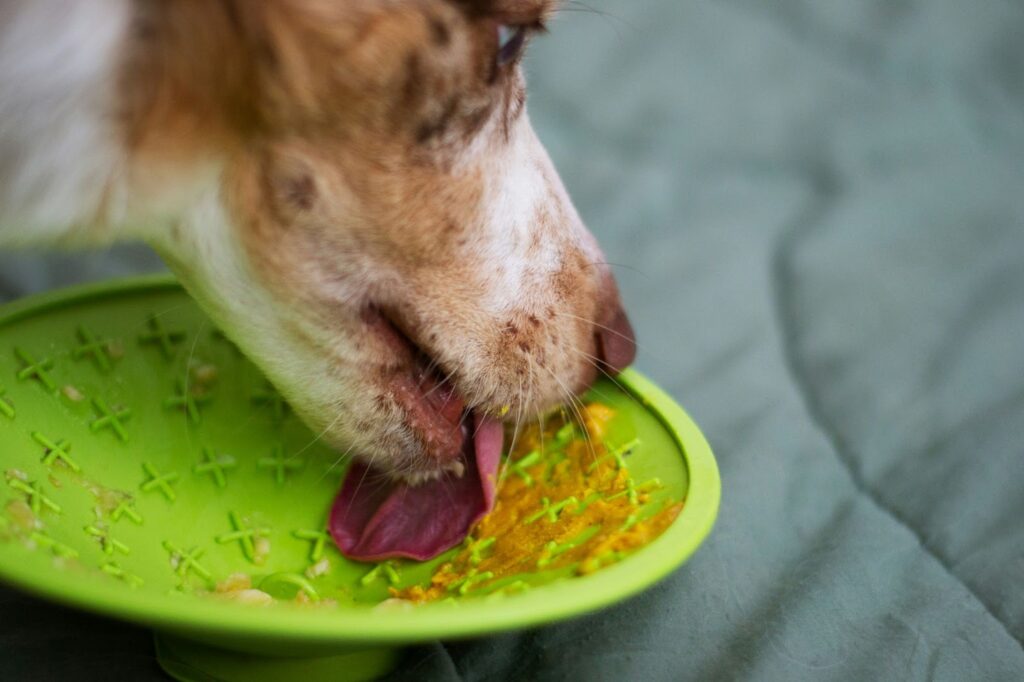If you’ve ever watched your dog hoover up their dinner as though they hadn’t seen food for days, you’re not alone. Fast eating is a common quirk among many dogs: especially puppies, rescue dogs, or those living in multi-dog households where mealtime can feel like a race.
But while the behaviour may seem harmless, it can spell trouble if left unchecked. Dogs that bolt their food risk choking, bloating, and digestive issues – none of which you want to see your beloved pet endure.
The good news? You can take simple steps to help your dog slow their pace, enjoy their meals more, and safeguard their health in the process.
Why Do Some Dogs Eat Too Fast?
Some dogs scarf down their meals due to natural instincts, while others may be responding to past experiences or current stressors. Let’s take a closer look:
- Instinct to compete for food — In the wild, dogs competed with their pack for limited resources. Many still carry this instinct, which triggers fast eating, even when there’s plenty to go around.
- Anxiety or excitement — Some dogs become so revved up at mealtime that they can’t control the urge to gulp.
- Previous scarcity — Rescue dogs or those with a rough start in life may have learned to eat quickly before food disappeared. This can take time to retrain.
- Learned behaviour in multi-pet homes — In households with multiple dogs, meals can turn into a race, encouraging dogs to eat faster than they should.
No matter the cause, teaching your dog to slow down can ease stress, reduce health risks, and create a calmer mealtime experience for both of you.
Why Eating Too Fast Can Be Harmful
While watching a dog polish off a bowl in seconds might seem amusing at first, the risks are very real:
- Choking hazard — Gulping large mouthfuls increases the risk of food getting stuck in the throat.
- Vomiting or indigestion — Fast eaters often swallow air along with their food, leading to upset stomachs, regurgitation, and discomfort.
- Bloat (gastric dilatation-volvulus) — In large and deep-chested breeds, rapid eating can trigger this life-threatening condition. Early intervention is key, but prevention is best.
- Poor nutrient absorption — Food that’s barely chewed moves through the system too quickly, reducing the body’s ability to fully absorb nutrients.
Helping your dog slow down won’t just protect their health. It can also turn mealtime into a more relaxing, enriching experience.
Tips to Help Your Dog Eat More Slowly
You’ve spotted the issue, and now you’re ready to tackle it. The good news is, helping your dog take a more measured approach to meals doesn’t require a complicated plan or fancy equipment, though the right tools and techniques certainly help.
One of the easiest starting points is to swap your dog’s regular bowl for a slow feeder. These clever dishes feature raised patterns or ridges that force your dog to work their tongue and teeth around the obstacles to reach the food. The result? Smaller bites, more chewing, and a natural slowing of pace. Slow feeders now come in every shape, size, and style imaginable, so you can easily find one that suits your dog’s breed, size, and eating style.
Another option that works wonders for both body and mind is the use of food puzzle toys. These engaging feeders turn mealtime into a bit of a game, requiring your dog to figure out how to access each morsel. High-energy dogs, working breeds, and curious pups especially benefit from this added mental stimulation while also pacing their intake.
If your dog tends to inhale large meals, splitting the portions can help, too. Instead of serving one large meal twice daily, consider breaking meals into smaller servings offered throughout the day. Smaller amounts eaten more frequently help prevent that urge to gorge, while keeping your dog feeling comfortably full and satisfied.
For an even simpler hack, try spreading their meal across a large, flat surface such as a baking tray or lick mat. This forces your dog to eat more deliberately, as the food is no longer piled in one place for easy scooping. Many owners find that this technique alone works wonders for slowing the fastest eaters.
Hand feeding also deserves a mention. This is especially useful for puppies in training or dogs who display anxiety around food. Feeding by hand not only helps them pace themselves but also builds trust and strengthens your bond. Plus, it reinforces calm behaviour around food, helping to address underlying excitement or competition issues.
Finally, take a look at your dog’s overall mealtime environment. In homes with multiple pets, feeding dogs separately can help reduce competition and allow each pet to eat at their own pace. Encourage calm behaviour before meals. Avoid hyping them up. If they’ve just returned from an epic forest run and you’ve just taken off their dog goggles, don’t expect them to be ready for a calm mealtime.
When to Consult a Vet
Sometimes, fast eating signals more than old habits or simple excitement. If you notice a sudden change in how your dog approaches meals—for example, a dog who previously ate slowly now bolts their food with urgency—it’s worth booking a visit with your vet. Sudden shifts in eating speed can sometimes indicate discomfort, anxiety, or underlying health concerns that deserve professional attention.
You should also reach out if your dog shows any troubling signs around mealtime, such as persistent vomiting, bloating, retching, or visible discomfort after eating. These could point to conditions that require urgent care, particularly in breeds prone to gastric bloat. The same applies if your dog displays anxious behaviour around food that doesn’t ease with training and environmental changes.
In these cases, your vet can help rule out medical causes, advise on the safest feeding strategies for your dog, and suggest whether additional behavioural support is needed.

